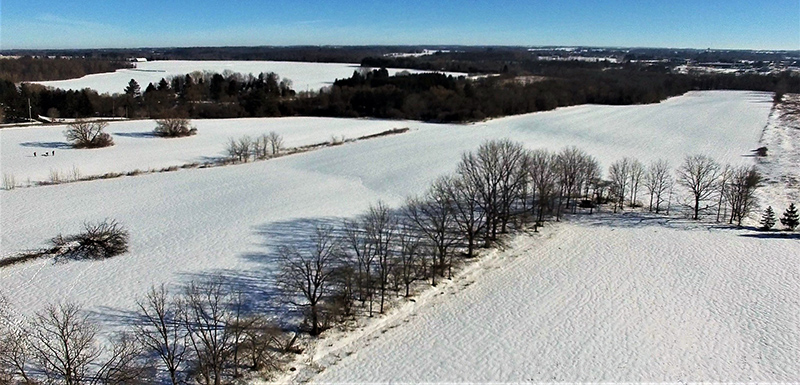Thorndale Demonstration Farm (UTRCA Weekly, March 26, 2021)
March 26, 2021 – The Upper Thames River Conservation Authority (UTRCA) has established a new, 58 acre demonstration farm near Thorndale, Ontario. The farm will demonstrate various best management practices (BMPs) and showcase how they can improve soil health and local water quality. Staff expect that there will be widespread benefits, as farmers implement BMPs from the demonstration farm on their own property, and expand the positive impact across the watershed.
We asked Craig Merkley, UTRCA Conservation Services Specialist, to tell us about the project.
1) How did the idea of a demonstration farm come about?
The idea evolved over many years. The UTRCA has been involved in promoting, implementing and demonstrating agricultural BMPs for more than 40 years. Our Conservation Service team has worked on several small watershed projects where specific BMPs were implemented and monitored for research and demonstration purposes. These projects have been very successful and created a lot of interest in the farming community. It seemed like a natural fit that we should take one of our own farm properties and implement BMPs as part of its management – we could take all of the BMPs we have experience with in other parts of the watershed and implement them in one location.
Water quality improvement projects like this also support the UTRCA’s Environmental Target to improve each subwatershed’s water quality score by one grade, as measured by UTRCA Watershed Report Cards, by the year 2037. Our mandate includes reducing flooding, as well, and an obvious pathway to achieving this goal is to encourage conservation practices on farmlands that are contributing stormwater runoff. Conservation BMPs will improve soil health, which increases the soil’s ability to retain water and then release it slowly.
2) Why this property?
The UTRCA acquired this particular property during construction of the Fanshawe Dam in the early 1950s, and has rented the fields out for production ever since. We chose this site because it represents a typical landscape found in the upper Thames River watershed. It’s good quality farmland with gentle to moderate slopes, and has the potential to demonstrate several innovative BMPs. The property is also close to the road and highly visible to people passing by.
3) How is this project going to benefit farmers?
A big part of expanding BMP uptake is showing as many farmers as possible these ideas and how they could fit into their management. By demonstrating BMP features here, we’re providing local farmers with examples of what they can achieve on their own farms in the watershed. The project will also have wider benefits – sharing knowledge is key to widespread BMP adoption and, ultimately, improving and protecting the health of the Thames River watershed and Great Lakes water quality.
Find out more about agricultural BMPs
4) Have you received any interest from people wanting to be involved or have a tour of the farm?
The Thorndale Demonstration Farm Project is being supported by the local agricultural drainage industry and recognized by both Federal and Provincial funders. The project is also supported by local agricultural organizations and federations. It is an excellent vehicle to draw the type of support needed to make the project a success.

5) What are the long term aspirations for this farm?
We expect the demonstration farm will evolve with time. As with all practices, things change and farmers have to adapt to changes in the industry. This farm will be a place to demonstrate these changes and show how implementing BMPs can provide viable, long term environmental sustainability on the farming landscape and economic viability for producers.
While the farm was just recently established, we have many plans for the future including water and sediment control basins, cover crops, minimum and no-till planting, roadside and block tree planting, woody fence-row management, and woodlot management. Over the winter, staff pruned the tree buffers throughout the property. We are also working on a pollinator project to increase the general biodiversity of the land and showcase how important that is. In time, we’ll install a kiosk on the property with information about what’s happening on the site and, once public health guidelines permit, we will host tours and field days.
Thorndale Demonstration Farm – pruning treed buffer (photos)
6) Who are the project funders and partners?
We’ve received financial support from many sources, including the Government of Canada through the federal Department of Environment and Climate Change, and the Ontario Ministry of Agriculture, Food & Rural Affairs, as well as ADS Canada (formerly Ideal Drain Tile); Agri Drain Corporation; Bluewater Pipe Inc; and McCutcheon Farm Drainage.
Other supporters include Land Improvement Contractors of Ontario; Middlesex Federation of Agriculture; and Middlesex Soil and Crop Improvement Association.
As the project progresses, we anticipate more industry partners, such as other drainage contractors, to take part, as well as academia.

